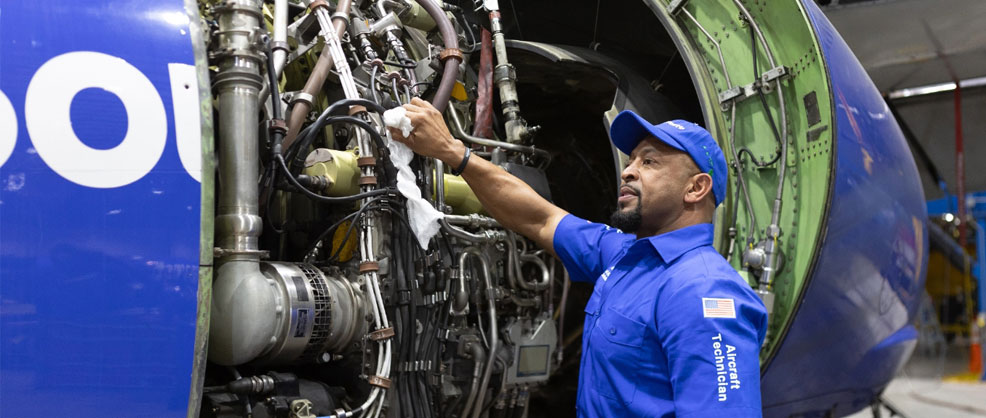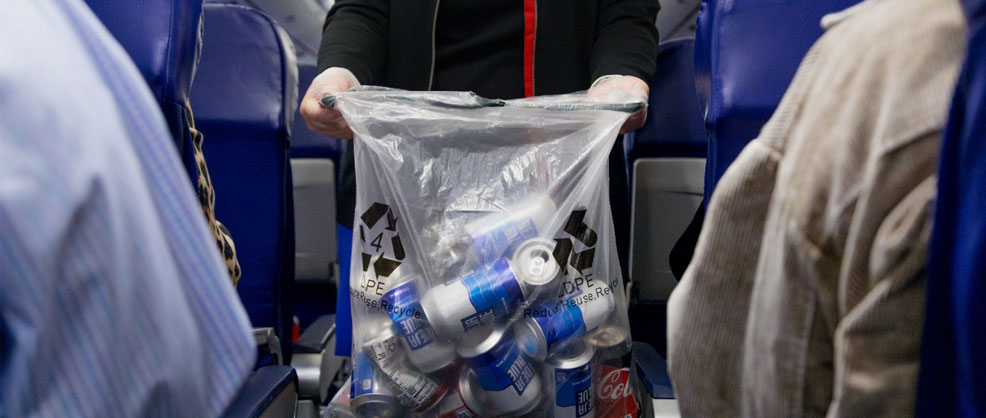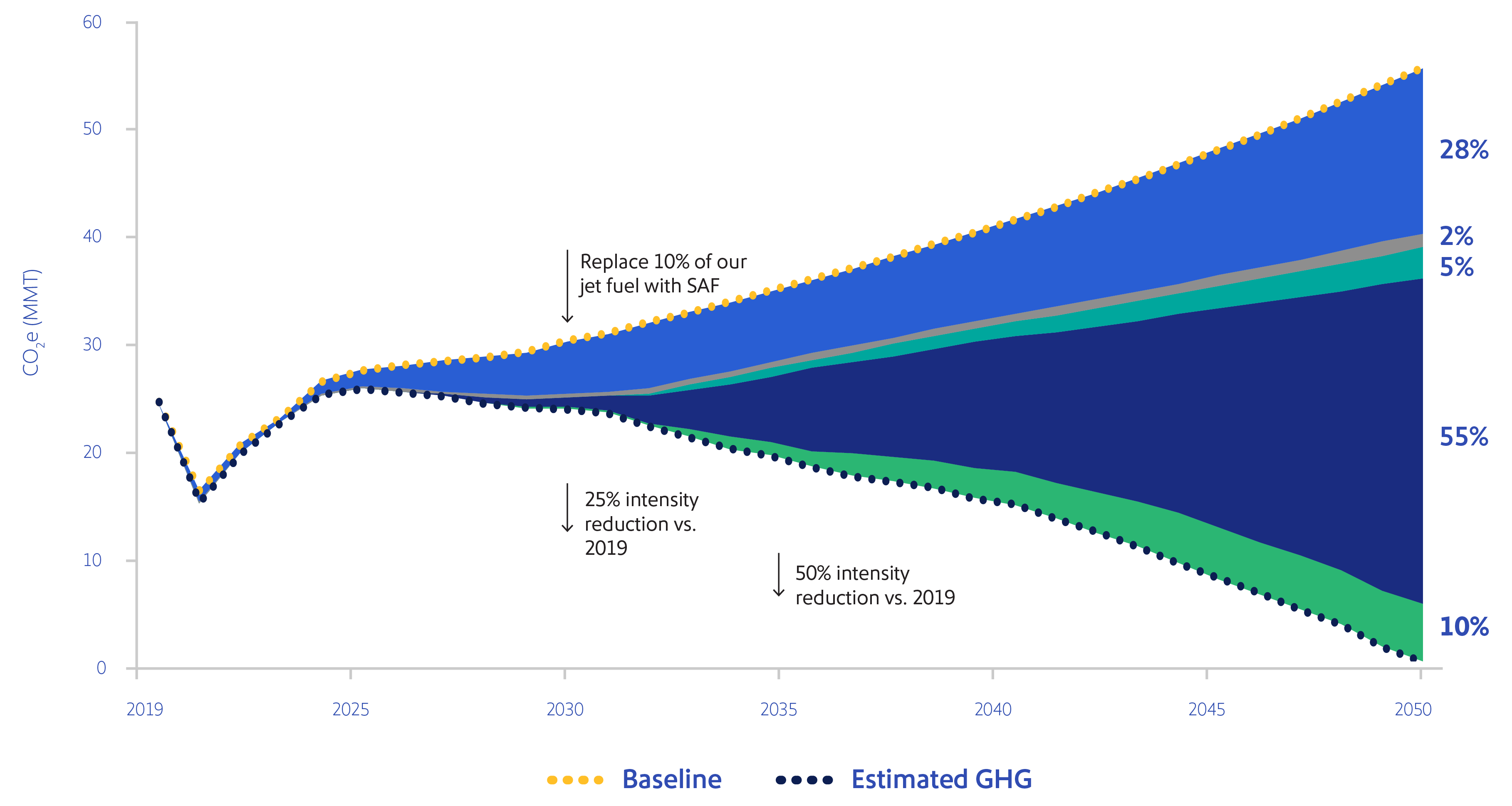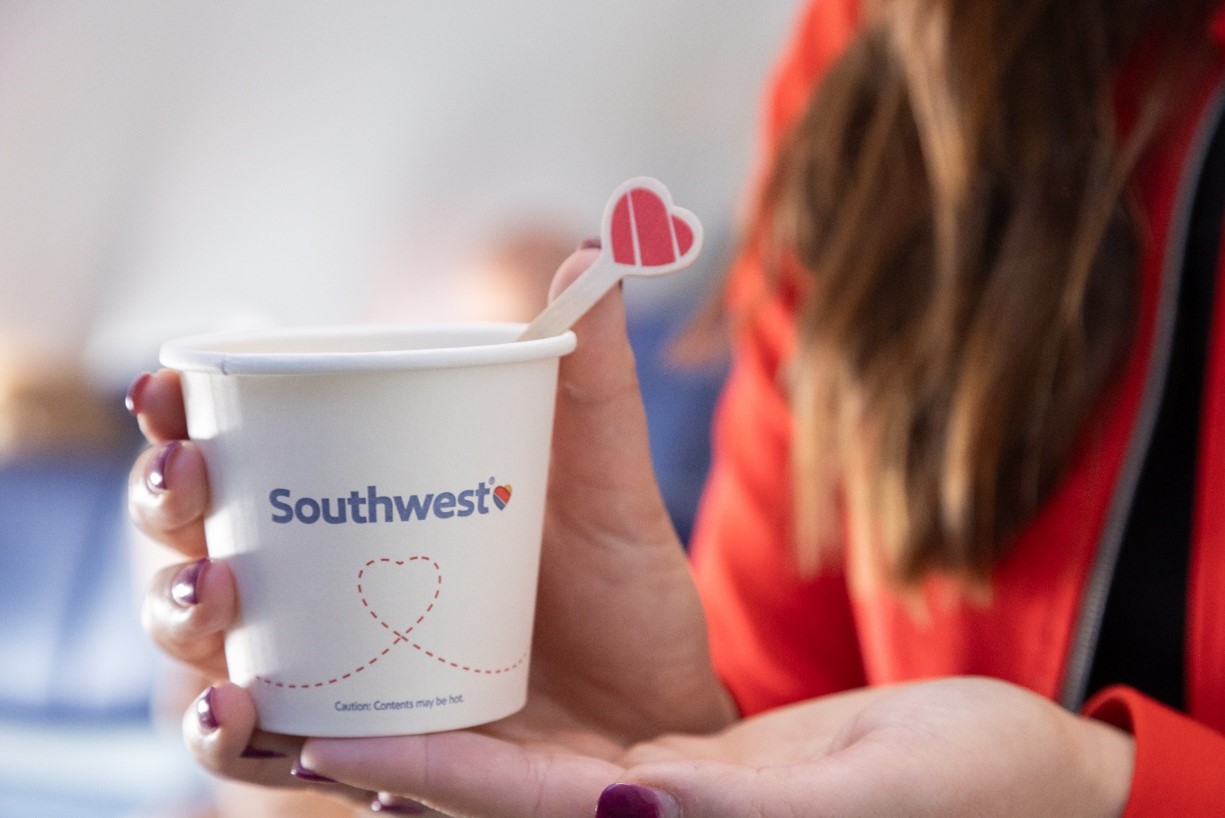Planet
At Southwest Airlines®, we take pride in being the airline with Heart and that includes respecting our Planet. Our goal is to achieve net zero carbon emissions by 20501, which will require a strategic mix of advanced long-term planning and near-term action. We are working to make progress across our strategic areas of focus to help us achieve our near and long-term sustainability goals and beyond.

Our path toward net zero carbon emissions
by 20501 and a more sustainable future.

 Carbon
Carbon
Addressing our carbon emissions through fleet renewal, fuel and operational efficiency initiatives, sustainable aviation fuel (SAF), electrification of ground support equipment, energy conservation, and other initiatives.

 Circularity
Circularity
Working toward improving sustainability in our operations through sourcing, recycling, and upcycling.

 Collaboration
Collaboration
Partnering with organizations whose work complements our efforts to achieve our goals and engaging with our suppliers on sustainability.
Our net zero by 2050 goal1 includes Scope 1, Scope 2, and Scope 3 Category 3 emissions only and excludes any emissions associated with non-fuel products and services, such as inflight service items.
Environmental Sustainability Goals
2025
Reduce single-use plastics from inflight service 50% by weight2
2030
Reduce our carbon emissions intensity by 25%1
Replace 10% of total jet fuel consumption with SAF3
Save 100 million gallons of jet fuel from fuel efficiency initiatives between 2025 to 20304
Reduce single-use plastics from inflight service 70% by weight2
2035
Reduce emissions intensity by 50%1
Electrify 50% of eligible ground support equipment (GSE) systemwide5
Reduce energy utilization index (EUI) in our Dallas headquarters by 50%6
2050
Net zero carbon emissions1
Path to Net Zero1

- Fleet Renewal7
Innovative technologies continue to create potential improvements to the fuel efficiency and emissions intensity of our aircraft. We plan to continue replacing older, less efficient aircraft, and our projected path relies on our fleet modernization plans. We are dependent on manufacturers to deliver new aircraft and future technologies to achieve these reductions.
- SAF7
SAF is the most critical lever in achieving our Net Zero goal.1 We assume, among other things, that the SAF market will scale in alignment with the U.S. government’s SAF Grand Challenge, which aims at making three billion gallons of SAF available by 2030 and 35 billion gallons (100% of projected U.S. aviation jet fuel use) available by 2050.8 Additionally, we assume that SAF will reach an average carbon intensity (CI) of 15 gCO2e/MJ by 2050 given that the Clean Fuel Production Credit (CFPC) incentivizes lower carbon intensity SAF.
Verified Offsets7,9
While offsets aren’t part of our depicted Path to Net Zero1, they may play a role in contributing toward our 2050 net zero goal if any of the levers above are unable to provide currently anticipated reductions.
- Operational Efficiency7
Includes continued investment in internal fuel saving measures such as route optimization, single engine taxiing, engine washing, weight savings, and other initiatives.
- NextGen FAA7
Fuel efficiency improvements are anticipated over time due to ATC and other initiatives implemented by the FAA.
- Carbon Removals7
Captures carbon negative SAF (any SAF with reductions below a CI of 0 such as through the use of carbon capture and sequestration in the production process), that we may utilize. Additionally, includes potential removals through, for example, direct air capture (DAC) and other technologies that could become available or utilized by Southwest in the future.
- Alternative Propulsion7
We have engaged with companies working on novel aircraft and propulsion designs. We have found that most solutions are unlikely to replace large scale commercial aviation by 2050. We have not included these technologies in our depicted net zero transition plan.
For additional details on our environmental sustainability goals and initiatives, including our efforts across our three strategic areas of focus, please see the latest One Report.
Environmental Sustainability Plan
 Carbon
Carbon
Our plan includes the following goals: reducing our carbon emissions intensity 50% by 2035 and 25% by 2030 as compared with 20191. SAF plays an important role in our carbon emissions intensity reduction goals and overall sustainability strategy, and we have set a goal to replace 10% of our total jet fuel consumption with SAF by 2030.3
What are sustainable aviation fuels?
SAF is fuel produced from non-fossil fuel sources that can result in lower greenhouse gas (GHG) emissions than conventional jet fuel on a lifecycle basis. SAF is a drop-in fuel when blended with conventional jet fuel and is crucial to addressing aviation’s carbon emissions.
Learn more about SAF
Our SAF partners
We have set a goal to replace 10% of our total jet fuel consumption with SAF by 2030.3 In 2024, we continued to take action towards our SAF goal and utilized SAF in our operations.3 We also partnered with coalitions like the Sustainable Aviation Fuel Coalition and the Commercial Aviation Alternative Fuels Initiative, corporate Customers, policymakers, and other stakeholders to help develop this nascent market.
Fleet modernization and operational efficiencies

Fleet modernization
Modernizing our fleet with more fuel-efficient Boeing 737 aircraft. The 737 MAX 8 is approximately 14% more fuel-efficient than the 737-800. The 737 MAX 7 is expected to produce comparable fuel efficiency improvement compared with the 737-700.10

Electrification of ground support equipment (eGSE)
Electrifying 50% of eligible ground support equipment (GSE) system-wide by 2035.5

Operational efficiencies
Improving fuel efficiency in our operations through initiatives like engine washing, weight savings, route optimization, electrifying eligible GSE, and other initiatives.
In 2024, we launched Flightkeys—our new global flight-planning software that gives our Dispatchers a dynamic platform to efficiently manage flight plans and optimize routes, which helps enable increased fuel efficiency.

Energy consumption
Working toward our goal to reduce our energy utilization index (EUI) in our Dallas Corporate Campus by 50% by 2035.6
 Circularity
Circularity
As an airline, we generate waste and use natural resources. It’s important to address our impact, and we are working to improve sustainability in our operations through sourcing, recycling, and upcycling.
What does circularity mean at Southwest?
Circularity at Southwest means working towards reducing waste by maximizing the value of resources and keeping products and materials in circulation as long as possible, such as, for example, through reusing, recycling, and considering what happens to a product at the end of its lifecycle from the time that we start to source it.
This is an ongoing journey. Some of our current initiatives include:

Reducing single-use plastics from inflight service2
In 2024, we introduced new onboard service items that can help us work towards our goal to reduce single-use plastics from inflight services 50% by weight by 2025 and 70% by weight by 2030.2 In 2024, Southwest introduced new cold cups and stir sticks. The new cold cups are made from 93% non-plastic materials, with a pulp blend consisting of 75% bamboo and 25% paper, and a polyethylene (PE) lining. The new stir sticks are made from 100% Forest Stewardship Council11-certified birch wood

Recycling on our planes, in our buildings, and in our operations
Working to improve recycling through expanding access, improving data collection, increasing education, practicing consistency, and governing our recycling efforts.

Repurposing used materials into new products while partnering with the community
Looking for ways to give products that have reached the end of their lifecycle new life through our Repurpose with Purpose upcycling program.

 Collaboration
Collaboration
Partnerships play an important role in our sustainability initiatives. We collaborate with a diverse range of organizations, nonprofit groups, policymakers, airports, suppliers, Customers, and other cross-industry partners whose efforts align with ours to help us reach our goals and further our environmental sustainability efforts.
Learn more about our sustainability partners
Southwest has taken action to help support contrails research.
Learn more about how we support contrails research
We understand the importance of biodiversity and fostering awareness in the communities we serve. In 2024, Southwest partnered with several groups dedicated to preserving and educating communities about our natural world through monetary and in-kind donations.
Learn more about our biodiversity efforts
Southwest has consistently advocated for public policies focused on achieving our goal of net zero carbon emissions by 20501 and our interim carbon intensity reduction targets1, including governmental policies and programs that support our ability to fly more efficiently and use more sustainable aviation fuel.
Learn more about our climate advocacy
Respecting our Planet for future generations to come is an important component to living out our Purpose. As part of our Environmental Policy, we've established guiding principles to seek to address our impact on the environment.
Learn more about our Environmental Policy
2Weight compared to a 2022 baseline and includes single-use plastics for inflight service. Single-use plastics from inflight service include: (1) the packaging (e.g., plastic bottles) from our snack and beverage program; (2) serviceware items including cups, lids, straws, stir sticks, and overwrap for napkins; and (3) other miscellaneous packaging (e.g., polywrap, coffee creamer container).
3Southwest continues to evaluate opportunities to procure and support the scaled production of SAF. SAF supply and related opportunities are subject to a number of legal, regulatory, financial, technical and commercial risks. Procuring increasing volumes of SAF for our operations is subject to a number of uncertainties outside our control, and while we may enter into various agreements for the offtake of, or investment in, the production of SAF, we cannot guarantee that the third parties we enter into these agreements with will ultimately be able to successfully deliver or produce sufficient volumes of SAF on commercially reasonable terms, if at all. Some SAF projects, including projects we have previously pursued or for which we have entered into offtake agreements, have not succeeded or could fail to succeed for reasons that may be outside our control, and we cannot guarantee that we will be able to successfully execute and/or commercialize future SAF-related opportunities. Any inability to procure SAF at sufficient volumes and on commercially reasonable terms could also impact our stated sustainability goals.
4In this context, "fuel savings" refers to the reduction in fuel consumption achieved through operational improvements and efficiency measures, such as aircraft weight reduction, single engine taxiing, minimized auxiliary power unit (APU) usage, optimized flight planning, and other fuel-efficient practices.
5Includes baggage-tugs, belt-loaders, and pushbacks.
6Reduce energy utilization index in our Dallas headquarters by 50% relative to a 2019 baseline.
77. Detailed risk factors, including those specific to extreme weather events and climate change, are discussed under the heading “Risk Factors” in the Company’s Annual Report on Form 10-K for the fiscal year ended December 31, 2024.
8See U.S. Department of Energy’s SAF Grand Challenger Roadmap released September 2022.
9Verified offsets are defined as credits that have undergone independent third-party verification by an accredited verification body to have followed the methodologies and protocols of the applicable program in the development and execution of project activities.
10The 737 MAX 8 is approximately 14% more fuel-efficient than the 737-800. The 737 MAX 7 is expected to produce comparable fuel efficiency improvement compared with the 737-700.
11The Forest Stewardship Council (FSC) and the Programme for the Endorsement of Forest Certification (PEFC) are two nonprofit organizations that certify forest products as sustainably sourced. Both organizations use independent third parties to verify that forests are managed responsibly.